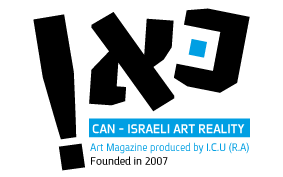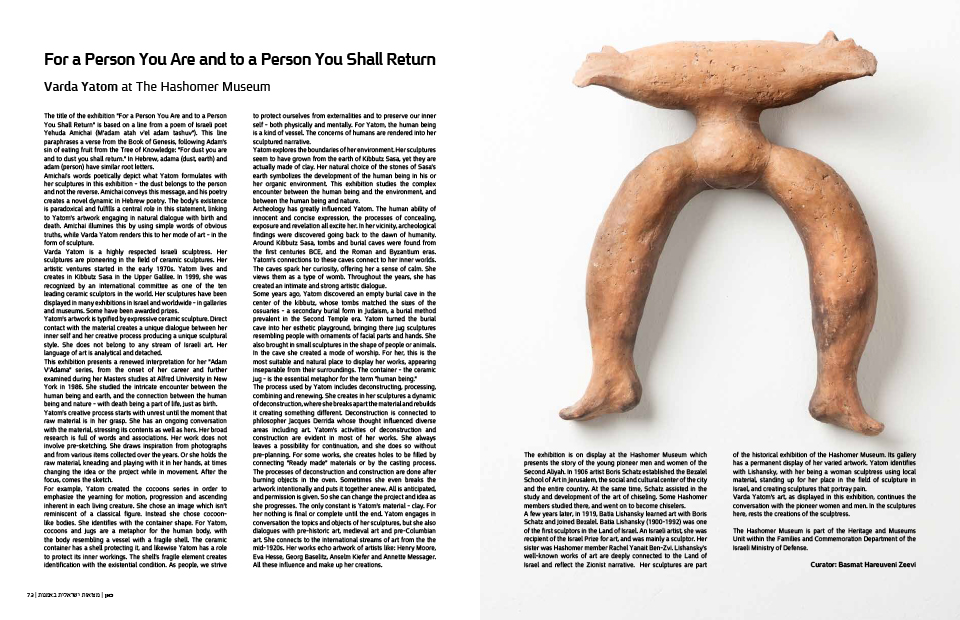
| Home Page | Editor Notices | Museums | Galleries | Publication | Donation | Contact Us |


 | |||||||||||||||
| |||||||||||||||


| |||||||||||||||
| Varda Yatom at The Hashomer Museum |
The title of the exhibition "For a Person You Are and to a Person You Shall Return" is based on a line from a poem of Israeli poet Yehuda Amichai (M'adam atah v'el adam tashuv"). This line paraphrases a verse from the Book of Genesis, following Adam's sin of eating fruit from the Tree of Knowledge: "For dust you are and to dust you shall return." In Hebrew, adama (dust, earth) and adam (person) have similar root letters. Amichai's words poetically depict what Yatom formulates with her sculptures in this exhibition – the dust belongs to the person and not the reverse. Amichai conveys this message, and his poetry creates a novel dynamic in Hebrew poetry. The body's existence is paradoxical and fulfills a central role in this statement, linking to Yatom's artwork engaging in natural dialogue with birth and death. Amichai illumines this by using simple words of obvious truths, while Varda Yatom renders this to her mode of art – in the form of sculpture. Varda Yatom is a highly respected Israeli sculptress. Her sculptures are pioneering in the field of ceramic sculptures. Her artistic ventures started in the early 1970s. Yatom lives and creates in Kibbutz Sasa in the Upper Galilee. In 1999, she was recognized by an international committee as one of the ten leading ceramic sculptors in the world. Her sculptures have been displayed in many exhibitions in Israel and worldwide – in galleries and museums. Some have been awarded prizes. Yatom's artwork is typified by expressive ceramic sculpture. Direct contact with the material creates a unique dialogue between her inner self and her creative process producing a unique sculptural style. She does not belong to any stream of Israeli art. Her language of art is analytical and detached. This exhibition presents a renewed interpretation for her "Adam V'Adama" series, from the onset of her career and further examined during her Masters studies at Alfred University in New York in 1986. She studied the intricate encounter between the human being and earth, and the connection between the human being and nature – with death being a part of life, just as birth. Yatom's creative process starts with unrest until the moment that raw material is in her grasp. She has an ongoing conversation with the material, stressing its contents as well as hers. Her broad research is full of words and associations. Her work does not involve pre-sketching. She draws inspiration from photographs and from various items collected over the years. Or she holds the raw material, kneading and playing with it in her hands, at times changing the idea or the project while in movement. After the focus, comes the sketch. For example, Yatom created the cocoons series in order to emphasize the yearning for motion, progression and ascending inherent in each living creature. She chose an image which isn't reminiscent of a classical figure. Instead she chose cocoon-like bodies. She identifies with the container shape. For Yatom, cocoons and jugs are a metaphor for the human body, with the body resembling a vessel with a fragile shell. The ceramic container has a shell protecting it, and likewise Yatom has a role to protect its inner workings. The shell's fragile element creates identification with the existential condition. As people, we strive to protect ourselves from externalities and to preserve our inner self – both physically and mentally. For Yatom, the human being is a kind of vessel. The concerns of humans are rendered into her sculptured narrative. Yatom explores the boundaries of her environment. Her sculptures seem to have grown from the earth of Kibbutz Sasa, yet they are actually made of clay. Her natural choice of the stones of Sasa's earth symbolizes the development of the human being in his or her organic environment. This exhibition studies the complex encounter between the human being and the environment, and between the human being and nature. Archeology has greatly influenced Yatom. The human ability of innocent and concise expression, the processes of concealing, exposure and revelation all excite her. In her vicinity, archeological findings were discovered going back to the dawn of humanity. Around Kibbutz Sasa, tombs and burial caves were found from the first centuries BCE, and the Roman and Byzantium eras. Yatom's connections to these caves connect to her inner worlds. The caves spark her curiosity, offering her a sense of calm. She views them as a type of womb. Throughout the years, she has created an intimate and strong artistic dialogue. Some years ago, Yatom discovered an empty burial cave in the center of the kibbutz, whose tombs matched the sizes of the ossuaries – a secondary burial form in Judaism, a burial method prevalent in the Second Temple era. Yatom turned the burial cave into her esthetic playground, bringing there jug sculptures resembling people with ornaments of facial parts and hands. She also brought in small sculptures in the shape of people or animals. In the cave she created a mode of worship. For her, this is the most suitable and natural place to display her works, appearing inseparable from their surroundings. The container – the ceramic jug – is the essential metaphor for the term "human being." The process used by Yatom includes deconstructing, processing, combining and renewing. She creates in her sculptures a dynamic of deconstruction, where she breaks apart the material and rebuilds it creating something different. Deconstruction is connected to philosopher Jacques Derrida whose thought influenced diverse areas including art. Yatom's activities of deconstruction and construction are evident in most of her works. She always leaves a possibility for continuation, and she does so without pre-planning. For some works, she creates holes to be filled by connecting "Ready made" materials or by the casting process. The processes of deconstruction and construction are done after burning objects in the oven. Sometimes she even breaks the artwork intentionally and puts it together anew. All is anticipated, and permission is given. So she can change the project and idea as she progresses. The only constant is Yatom's material – clay. For her nothing is final or complete until the end. Yatom engages in conversation the topics and objects of her sculptures, but she also dialogues with pre-historic art, medieval art and pre-Columbian art. She connects to the international streams of art from the the mid-1920s. Her works echo artwork of artists like: Henry Moore, Eva Hesse, Georg Baselitz, Anselm Kiefer and Annette Messager. All these influence and make up her creations. The exhibition is on display at the Hashomer Museum which presents the story of the young pioneer men and women of the Second Aliyah. In 1906 artist Boris Schatz established the Bezalel School of Art in Jerusalem, the social and cultural center of the city and the entire country. At the same time, Schatz assisted in the study and development of the art of chiseling. Some Hashomer members studied there, and went on to become chiselers. A few years later, in 1919, Batia Lishansky learned art with Boris Schatz and joined Bezalel. Batia Lishansky (1900-1992) was one of the first sculptors in the Land of Israel. An Israeli artist, she was recipient of the Israel Prize for art, and was mainly a sculptor. Her sister was Hashomer member Rachel Yanait Ben-Zvi. Lishansky's well-known works of art are deeply connected to the Land of Israel and reflect the Zionist narrative. Her sculptures are part of the historical exhibition of the Hashomer Museum. Its gallery has a permanent display of her varied artwork. Yatom identifies with Lishansky, with her being a woman sculptress using local material, standing up for her place in the field of sculpture in Israel, and creating sculptures that portray pain. Varda Yatom's art, as displayed in this exhibition, continues the conversation with the pioneer women and men. In the sculptures here, rests the creations of the sculptress. The Hashomer Museum is part of the Heritage and Museums Unit within the Families and Commemoration Department of the Israeli Ministry of Defense. Curator: Basmat Hareuveni Zeevi Read more  |
| all rights reserved - CAN ISRAELI ART REALITY |
| סייבורג מחשבים - בניית אתרים |